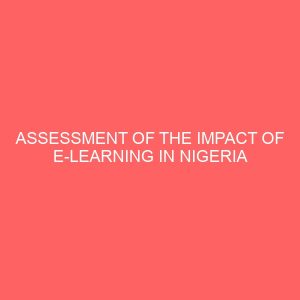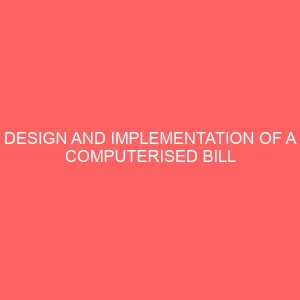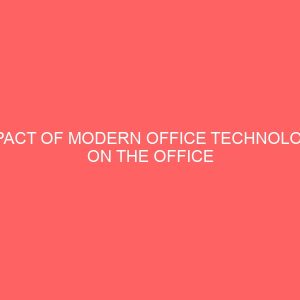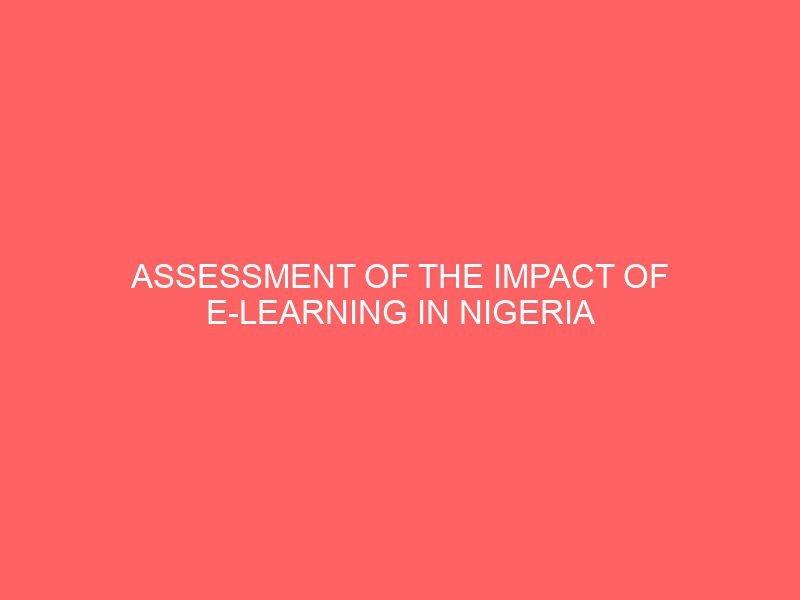Description
ABSTRACT
This study focused on the impact of e-learning in Nigerian schools. The study relates to a level one undergraduate module delivered using traditional lectures and e-learning based methods. E-learning has been revealed in this study not to have a positive impact on academic achievement contrary to the expectations of this study.
The research also examines the data for the presence of interaction effects between e-learning study hours and socio-demographic characteristics. This is undertaken to identify whether or not personal characteristic related learning style differences influence the extent to which students benefit from e-learning. It is found that, after controlling for other factors, female students benefited less from e-leaning material than their male counterparts.
The methodology that was employed in this study was systematic random sampling for students under traditional study mode and purposive sampling in identification of students under the e-learning study mode.
It is concluded that in order to improve teaching effectiveness and academic achievement, higher education should consider aiming to develop e-learning teaching strategies that encourage greater engagement and also take into consideration the different learning styles found within the student body.
The study recommends that critical factors such as institutional issue, management issue, pedagogical factors, technological issue, interface design issue, evaluation issue, and resource support issue and the factors within each issue have not yet been investigated with detail coverage. It further suggests that there is need to carry out detail research involving case studies based on survey questionnaires involving various learning institutions which will ultimately give a better understanding of impact of e-learning aspects within implementation process.
CHAPTER ONE
INTRODUCTION
1.1 BACKGROUND OF THE RESEARCH
E-learning according to Markus2008 can be defined as a learning process created by interaction with digitally delivered content, network based services and tutoring support E learning is any technologically mediated learning using computers whether from a distance or in face to face classroom setting computer assisted learning, it is a shift from traditional education or training to ICT based personalized, flexible, individual, self organized, collaborative learning based on a community of learners, teachers, facilitators, experts. E-learning is the use of Internet technologies to enhance knowledge and performance. E-learning technologies offer learners control over content, learning sequence, pace of learning, time, and often media, allowing them to tailor their experiences to meet their personal learning objectives. To manage access to e-learning materials, consensus on technical standardization, and methods for peer review of these resources. E-learning presents numerous research opportunities for faculty, along with continuing challenges for documenting scholarship. Innovations in e-learning technologies point toward a revolution in education, allowing learning to be individualized adaptive learning, enhancing learners interactions with others collaborative learning, and transforming the role of the teacher. The integration of e-learning into education can catalyze the shift toward applying adult learning theory, where educators will no longer serve mainly as the distributors of content, but will become more involved as facilitators of learning and assessors of competency. E-learning refers to the use of Internet technologies to deliver a broad array of solutions that enhance knowledge and performance. E-learning can be used by medical educators to improve the efficiency and effectiveness of educational interventions in the face of the social, scientific, and pedagogical challenges noted above. It has gained popularity in the past decade; however, its use is highly variable among medical schools and appears to be more common in basic science courses than in clinical clerkships. E-learning is also called Web based learning, online learning, distributed learning, computer assisted instruction, or Internet based learning. Historically, there have been two common e-learning modes: distance learning and computer assisted instruction. Distance learning uses information technologies to deliver instruction to learners who are at remote locations from a central site. Computer assisted instruction also called computer based learning and computer based training uses computers to aid in the delivery of standalone multimedia packages for learning and teaching. Multimedia learning. Multimedia uses two or more media, such as text, graphics, animation, audio, or video, to produce engaging content that learners access via computer. Blended learning, a fairly new term in education but a concept familiar to most educators, is an approach that combines e-learning technology with traditional instructor led training, where, for example, a lecture or demonstration is supplemented by an online tutorial. Faculty, administrators, and learners find that multimedia e-learning enhances both teaching and learning. These advantages can be categorized as targeting either learning delivery or learning enhancement. Learning delivery is the most often cited advantage of e-learning and includes increased accessibility to information, ease in updating content, personalized instruction, ease of distribution, standardization of content, and accountability. Accessibility refers to the users ability to find what is needed, when it is needed. Improved access to educational materials is crucial, as learning is often an unplanned experience. Updating electronic content is easier than updating printed material: e-learning technologies allow educators to revise their content simply and quickly. Learners have control over the content, learning sequence, pace of learning, time, and, often, media, which allows them to tailor their experience to meet personal learning objectives.
Internet technologies permit the widespread distribution of digital content to many users simultaneously anytime and anywhere. An additional strength of e-learning is that it standardizes course content and delivery; unlike, for instance, a lecture given to separate sections of the same course. Automated tracking and reporting of learners activities lessen faculty administrative burden. Moreover, e-learning can be designed to include outcomes assessment to determine whether learning has occurred. Advantages in learning enhancement are a less well recognized but potentially more revolutionary aspect of e-learning than are those related to learning delivery. E-learning technologies offer educators a new paradigm based on adult learning theory, which states that adults learn by relating new learning to past experiences, by linking learning to specific needs, and by practically applying learning, resulting in more effective and efficient learning experiences. Learning enhancement permits greater learner interactivity and promotes learners efficiency, motivation, cognitive effectiveness, and flexibility of learning style. Learning is a deeply personal experience: we learn because we want to learn. By enabling learners to be more active participants, a well designed e-learning experience can motivate them to become more engaged with the content. Interactive learning shifts the focus from a passive, teacher centered model to one that is active and learner centered, offering a stronger learning stimulus. Interactivity helps to maintain the learners interest and provides a means for individual practice and reinforcement. Evidence suggests that e-learning is more efficient because learners gain knowledge, skills, and attitudes faster than through traditional instructor led methods. This efficiency is likely to translate into improved motivation and performance. E-learners have demonstrated increased retention rates and better utilization of content, resulting in better achievement of knowledge, skills, and attitudes. Multimedia e-learning offers learners the flexibility to select from a large menu of media options to accommodate their diverse learning styles.
1.2 STATEMENT OF RESEARCH PROBLEM
The importance of education is increasing because of increasing pressure to catch up with the developed world regarding, for example, global competitiveness Hawkins 2006. Before the introduction of elearning many people who wanted to obtain university degree had to compete for the few places that were offered by the public universities. Those offered places had to apply for study leave as they had to go through the traditional learning system. This kind of further education system was characterized by limited number of students that could be absorbed per an academic year and consequent removal from their places of work for the duration of their study.
1.3 OBJECTIVES OF THE STUDY
1.3.1 General Objective
The general objective of this study is to access and evaluate the impact of elearning on academic in Nigerian schools
1.3.2 Specific Objectives of the Study
- To establish the role prior computer skills play in academic.
2. To provides personalized learning support through information, advice, and guidance services.
3. To establish a virtual learning worlds where learners can take part in active and creative learning with others through simulations, role play, remote control of real world tools and devices, online master classes, or collaboration with other education providers.
4. To determine the impact of socio-demographic characteristics on academic achievement.
5. To establish the impact of number of hours spent online/offline Time management on academic achievement.
1.4 RESEARCH QUESTION
For the purpose of this research, the followings are the fundamental research questions asked and would be analysis in this study:
- To what extent do prior computer skills play in academic performance
2. To what extent do socio-demographic characteristics influence academic achievement
3. Does e-learning help the students improve their grades, skills, values, procedures and technology necessary to apply in their jobs.
4. What role does prior computer skills play on academic and in students education level
5. What are the factors or personal issues that may influence the effect of e-learning and acceptance of the new technology in the educational section
6. To what extent does the level of engagement hours online/offline in the e-learning process affect academic achievement








Reviews
There are no reviews yet.